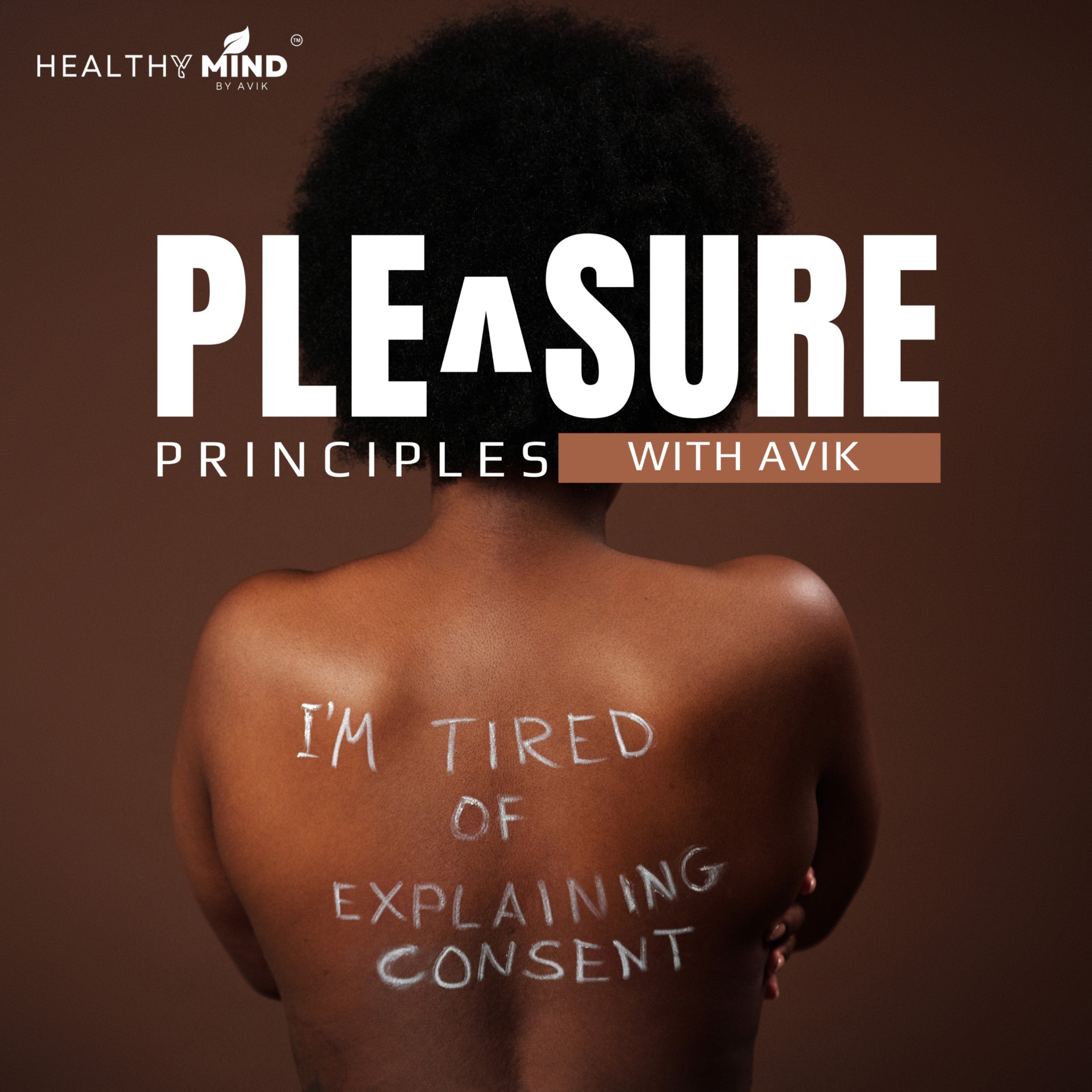.jpg)
Mind Over Masculinity
Let’s stop asking men to "man up" and start asking how we can lift them up. After all, mental health is not just a women’s issue or a men’s issue—it’s a human issue.
Take the first step today. Talk, listen, and advocate. Together, we can make a difference.
Mind Over Masculinity
Transforming Suicidal Ideation: Embracing Holistic Healing and Emotional Strength for Personal Growth and Mental Well-Being with Michael Blair
Uncover transformative tools for managing suicidal ideation and trauma with Michael Evan Blair, a seasoned expert in mental health education. Through an enlightening conversation, we promise you'll gain insight into early indicators of suicidal thoughts and explore Michael's innovative Spin Release, Replace, Reprogram Process. This practical tool allows individuals to manage overwhelming emotions by transforming them into manageable shapes and colors, reducing their impact through a unique visualization exercise. Discover how these tangible solutions can be a lifeline for those facing mental health challenges or supporting someone who is.
Our episode also emphasizes the power of a holistic approach to healing by integrating faith, spirituality, and community support with therapeutic methods. Michael shares a heartfelt story about Mia, a young girl who reclaimed her confidence through self-forgiveness and emotional regulation. We address the critical importance of seeking help for suicidal ideation, challenging harmful stereotypes, and nurturing emotional strength. As the host of Mind Over Masculinity, I invite you to join us in holding onto hope and embracing the journey to mental well-being, reinforcing that there is always a path forward and a reason to continue.
Automate Social Media Post
Make Short Clips From Long Videos
Loved by 4M+ marketers, entrepreneurs & creators
Create and translate videos
Create and translate videos with HeyGen's AI Video Generator
Buzzsprout Podcasting
Disclaimer: This post contains affiliate links. If you make a purchase, I may receive a commission at no extra cost to you.
-----------------------------------------------------------------------------------------------------------------
Want to be a guest on Mind Over Masculinity? Send me a message.
-----------------------------------------------------------------------------------------------------------------
Stay Tuned And Follow Us!
- YouTube - https://www.youtube.com/@healthymind-healthylife
- Instagram - https://www.instagram.com/podhealth.club/
- Threads - https://www.threads.net/@podhealth.club
- Facebook - https://www.facebook.com/podcast.healthymind
- LinkedIn - https://www.linkedin.com/in/newandnew/
I'm going to show you how to make a beautiful, beautiful, beautiful, beautiful, beautiful, beautiful, beautiful, beautiful, beautiful, beautiful, beautiful, beautiful, beautiful, beautiful, beautiful, beautiful, beautiful, beautiful, beautiful, beautiful, beautiful, beautiful, beautiful, beautiful, beautiful, beautiful, beautiful, beautiful, beautiful, beautiful, beautiful, beautiful, beautiful, beautiful, beautiful, beautiful, beautiful, beautiful, beautiful, beautiful, beautiful, beautiful, beautiful, beautiful, beautiful, beautiful, beautiful, beautiful, beautiful, beautiful, beautiful, beautiful, beautiful, beautiful, beautiful, beautiful, beautiful, beautiful. Thank you. So so, hello and welcome back listeners to Mind Over Masculinity, the show where we redefine what it means to be a man in today's world, free from stereotypes, free from unrealistic expectations and rooted in authenticity. Expectations and rooted in authenticity. I'm your host, sana, and in each episode we explore how men can embrace emotional well-being, self-awareness and genuine strength without sacrificing vulnerability. We believe it's time to break the mold and challenge outdated beliefs. So let's quickly dive in, and today let me introduce my guest to all of you listeners.
Speaker 1:I'm honored to be joined by a remarkable guest, michael Evan Blair, who brings over 30 years of experience in mental health education, training and evidence-based applications, both in person and over zoom listeners. Michael has compiled a powerful toolkit of recipes rooted in top tier inner mind psychology, designed to release, replace and reprogram deeply rooted traumas and issues faster than traditional methods. Having once dubbed himself president of the Never Enough Club of America, michael discovered that implementing these transformative tools not only healed his own struggles, but they also led to dramatic improvements for many of his clients. And today, on Mind Over Masculinity, we'll delve into how Michael's innovative strategies can address suicidal ideation, help rejoin identity and provide lasting self-maintenance tools for long-term growth and well-being. Whether you are someone dealing with suicidal thoughts or supporting a loved one, this conversation offers hope and tangible solutions. So, michael, with that, welcome to the show, and it's an absolute honor having you with us today.
Speaker 2:Well, it's really a pleasure to have a chance to share what's going on. It's really an exciting time in my life, at least in the area of mental health, because we've come across some really cool recipes that help everybody pretty much, but particularly focusing today on suicidal ideation and just trauma remediation, that sort of thing and generating a happy lifestyle out of an unhappy set of programming, I can tell you that after 34 years in the business, it's extremely fun at this point of time and at this age to have some, some cutting-edge tools to share with you.
Speaker 1:Definitely definitely so, Michael. With the first question, from your extensive experience, what are some of the earliest indicators that someone might be struggling with suicidal thoughts, and how can friends, or maybe family, how can they step in effectively?
Speaker 2:Really nice. Appreciate that those kinds of symptoms usually aren't that hard to really see. You can see depression, you can see anxiety, you can see shut down people who step aside from where their normal routine would be socially and their work slows down, etc. And so there are lots and lots of symptoms. We do a thorough symptom assessment in order to determine what recipe works best for the people we work with, and so we go to zero to 10. 10 is awful. Tell us how you're doing these days with anxiety, with depression, with trauma, history, memories, et cetera. And so then we begin to look at how can we best be helpful.
Speaker 2:One of those really cool tools that's come out maybe it's my favorite really is called the Spin Release, replace, reprogram Process, spinner, or the spin to be brief. And so I wrote a book. After thousands of applications with clientele that had come to see me, I decided you know what. This has got to be shared, so that it can be used by the common man in his own home or in his own life and with his friends or with his family, to be able to address this in a very simple way, and in just a few minutes I'm going to share with you an example of how this could be helpful.
Speaker 1:Okay, Okay, that's really great. If you can please, Michael, we would love to hear.
Speaker 2:Let's imagine that somebody comes to you and they say you know what I'm really feeling like? You know suicidal, or I'm just depressed out of my brain. I just don't want to stick around here anymore. And so one of the very, very first questions I ask people who have that going on, after we've built a little bit of rapport and there's some kind of connection between us is to say well, where do you feel that in your body? And they'll say, oh, in my chest or my stomach or somewhere like that.
Speaker 2:Then I go ahead and I step into the first part of what I call the spin, and I say so imagine for a moment that you can just pull that feeling right out of you into the room or the space in which you are and make it into a shape and a color. And, surprisingly, almost everybody can do this and do it very quickly. Let's just say a red triangle. Tell me what direction this spins in. And they'll tell you, oh, it spins to the left, for example. And I'll say, okay, now I'd like you to reverse that spin at hyperspeed to the right or to the reverse direction as fast as you possibly can, like a high-speed washing machine or like a tornado, to spin it out.
Speaker 2:And people actually are in most cases able to go to work and get that done. And they spin it out. And I ask them the question so tell me, how did you disappear it when you had it spun out? And they'll say, well, I blew it up, or I gave it to God, or I smashed it, or I you know all kinds of wonderful descriptions of how people disappear. That what's interesting is, at that point in time when they've done that, almost everybody, including those who are suicidal, are free, temporarily at least, from that initial pain and, surprisingly, are feeling, you know, kind of even keel for a moment. The rest of the spin follows and there's some really wonderful installations of healthy, self-chosen feeling states, which I'm not going to go into detail right now. But those and that process of installing those wonderful healthy feeling states is really powerful and that adds in additional interruption to the suicidal ideation and gives a direction, at least until additional other private therapy can be provided.
Speaker 1:Well, you know, it sounds really very effective. It kind of, you know, when I was also imagining a red triangle, I kind of thought, you know, let's spin it towards the right side. But anyway, your methods, they emphasize quick resolution, taking from listeners' perspective. You know real lasting healing is a slow process, so they would worry that a fast fix it might overlook deeper issues. So how do you respond to this concern that faster methods might just offer temporary relief? Michael?
Speaker 2:Well, the good news is that this process, surprisingly, does have effect very quickly I'm not saying it's always comprehensive in a one-time, true. So I recommend additional treatment and we utilize a modality we call TCT or trauma conversion therapy, which is another recipe which deals at the inner, inner psychology level that these are. Both of these tools, by the way, are tools that have to be experienced. You, it's like you can't taste this. You don't know what salt tastes like until you taste it, and so so in order for you to experience the power that these each have, you got to have a taste of it.
Speaker 2:And so, in the case of the spin, page 39 of my book when in Doubt, spin it Out, which has recently been put on the Amazon marketplace, page 39 gives a wonderful training to people online through a QR code so that they can begin in one or two hours to really do this for themselves or help their children, or help other people as well. And so, short-term and or long-term, there is some. There's a way to get through this. I might say that repetitive spins sometimes are necessary to get 100%, and a TCT is a comprehensive process that gets a lot larger, more comprehensive coverage of the pain that people carry from memory than usually the spin by itself will do. However, repetitive spins can also achieve that outcome, whether they're self-administered or whether they're administered by a professional who can really fine-tune things.
Speaker 1:Makes sense. Makes sense, Michael. Also, you have developed a set of recipes based on top-tier inner mind psychology. So if you can break down for our listeners what these recipes are and how do they specifically address suicidal thinking?
Speaker 2:So, as I've talked about earlier with regards to the suicidal thinking, it's the same process of going through and doing that same kind of thing, but adding to that the finishing touches that go on with the installation of the good stuff in the spin process. Let me give you an example. This affects men and women, of course. So Lisa and Mark were fighting every day. Years of unresolved resentment had turned every conversation into a battle. Mark stumbled across, went in doubt, spin it out and convinced Lisa to try it. They read page 39 together and practiced the process. They each spun out their anger, replacing it with forgiveness and compassion. For the first time in years, they sat down and had a calm, honest conversation. It's like we finally understand each other. Lisa said. Now they use the process weekly not just to resolve conflict but to strengthen their bond. Of course, relationships are critical to the mental health of virtually everyone, and so no doubt suicidal ideation stems from relationship malformation oftentimes, and so this type of story indicates another way to feel better and come to a better place with your relationship.
Speaker 1:Interesting. That is interesting and you know quick resolution is crucial in a crisis. But how do we ensure you know? After using these approaches, a person's identity is rejoined and they gain lifetime self-maintenance tools. So how does re-establishing a sense of self-help prevent suicidal thoughts?
Speaker 2:Well, I want to tell you that what we've learned is that getting the emotional pain out of the memories that people carry stops. That puts a stop, oftentimes, if not reduces dramatically the symptomology, the depression, the anxiety, the suicidal ideations, et cetera. When you have the emotional pain out, it stops the auto reactions that people have that lead them into those processes. And so that's the first that's a very, very major piece that you do remove the pain in one process or another. The spin does that, the TCT does that and we also do some self-forgiveness processing. That also helps people to release their pain Again when the pain's out and they gradually get over that and establish a new set of programming. The programming begins to overwrite the old scripts and people begin and generate and build, with a little bit of practice, build themselves into basically happy, flourishing people.
Speaker 1:Oh, interesting. That is interesting Also, michael, some listeners. They find strength in faith, spirituality or community support. So in your experience, how do these elements integrate with your therapeutic tools to create a holistic approach?
Speaker 2:There's no question, you're right about that. The sense of connection in the community, whether it's at the workplace like one lady just loves her team where she does a restaurant, another person in another area they just love the culture of that environment. So they have friends in their workplaces. Other people find it in their church or congregations or they find a connection there not only with their, their friendly people there, but also they develop a spirituality with their higher power and that higher power connection oftentimes also develops strong self-value positions that assist people through anything that used to be called suicidal ideation.
Speaker 2:Diagnostic can benefit from a closeness with other people where there's a safety and a security and a complementary relationship or friendship of some kind going on.
Speaker 2:So I like to think that, you know, with children for example, this tool is magnificent for children because moms I have many moms who will take their child when they come to them and say would you help me get past this bullying at school today, or this testitis I have, or this fear of this teacher or whatever's going on, I'm ready to go play now.
Speaker 2:Because they feel an immediate shift and are able to get off the old pattern shakeed, but also to actually shift the feeling states to a positive place that can be programmed in in a very pertinent way and build over time so that children don't collect the trash and keep it for a lifetime and make it into trauma. Later. They interrupt themselves and their families and they're ahead. So it's very possible that people can remain, if you will, clean and sober and flourish without all that collecting. Utilizing this on a regular basis, imagine every child or the children in a family having that tool learned before they leave home so that when they go go they know how to self forgive, they know how to to change their feel, their feeling states, to where they want them to be, instead of where they land and they've. They don't collect and they the stuff that most people do collect to interrupting their lives.
Speaker 1:Makes sense. Great, michael. So, before we wrap up this conversation, if you could offer one piece of advice to family members, or maybe friends, or even mental health professionals who are supporting someone experiencing suicidal ideation, what would it be?
Speaker 2:My personal preference would be to go to the easiest, quickest, most efficient, effective way to deal with that right now in the office and or in the home would be to get a copy of when in Doubt Spin it Out off of Amazon or however you want to get a hold of it. You can go to whenindoubtspinitoutcom or you can go to blaircounselingandcoachingcom and then through that resource you can find not only the material for the book but also coaching to help deepen it and make it better for those who do need that. So that would be my first choice. On the ground level, it's so cool to have a mom or a dad or an individual friendship that's able to really support, not just be friendly, but also to give them an actual process of shifting right there on the spot so they don't, and or to refer them to somebody who can or to a resource that can. I have one other story I think I should share with you real quick.
Speaker 2:At 16, mia was drowning in feelings of rejection after her first breakup. Her self-esteem shattered. She withdrew from friends and family. Her therapist introduced her to when in Doubt Spin it Out and walked her through the training on page 39 of that book, which is a get online from the book resource through a QR code. Mia visualized spinning out the hurt and replacing it with self-love and hope. For the first time in weeks, she smiled genuinely. Love and hope. For the first time in weeks, she smiled genuinely. Now Mia says I don't need someone else to make me feel loved. I can give that to myself. Her confidence has soared and she teaches her friends how to use the method as well. So it's really essential that you taste the salt here by going and actually getting involved in the experience of it. Through the page 39 in the QR code. That's where you really go. Oh my gosh, I can't believe it. I can take charge of my life. I didn't know I could do that.
Speaker 1:I mean these stories. They're, you know so powerful testaments to the, the effect of this entire you know thing you have created, and I think our listeners should definitely try it out, check it out, taste the salt mentioned. So, listeners, please refer to the show notes if you wish to get a hold of the work done by Michael and also Michael, thank you so much for sharing your powerful insights and compassionate strategies for addressing suicidal ideation, both in urgent moments and also through enduring self-care, and thank you, thank you, for sharing all these details. Thank you.
Speaker 2:Oh, you're welcome. It's really fun to be able to bring a breakthrough like this to the world community, and I'm grateful for those who are willing to taste the salt and who find the relief and the wonderful, flourishing life that's available to us even in a very challenging world scenario.
Speaker 1:Absolutely.
Speaker 2:Thank you for the opportunity.
Speaker 1:Great, great San To all of our listeners. If you or someone you know is struggling with suicidal ideation, please remember you are not alone. Reach out for professional support, confide in someone you trust and consider Michael's transformative recipes for lasting relief. And until then, this is your host, sana, signing off from Mind Over Masculinity. Until next time, keep challenging harmful stereotypes, nurturing your emotional strength, and remember there is always a path toward hope and a reason to keep going. Thank you.


.jpg)




